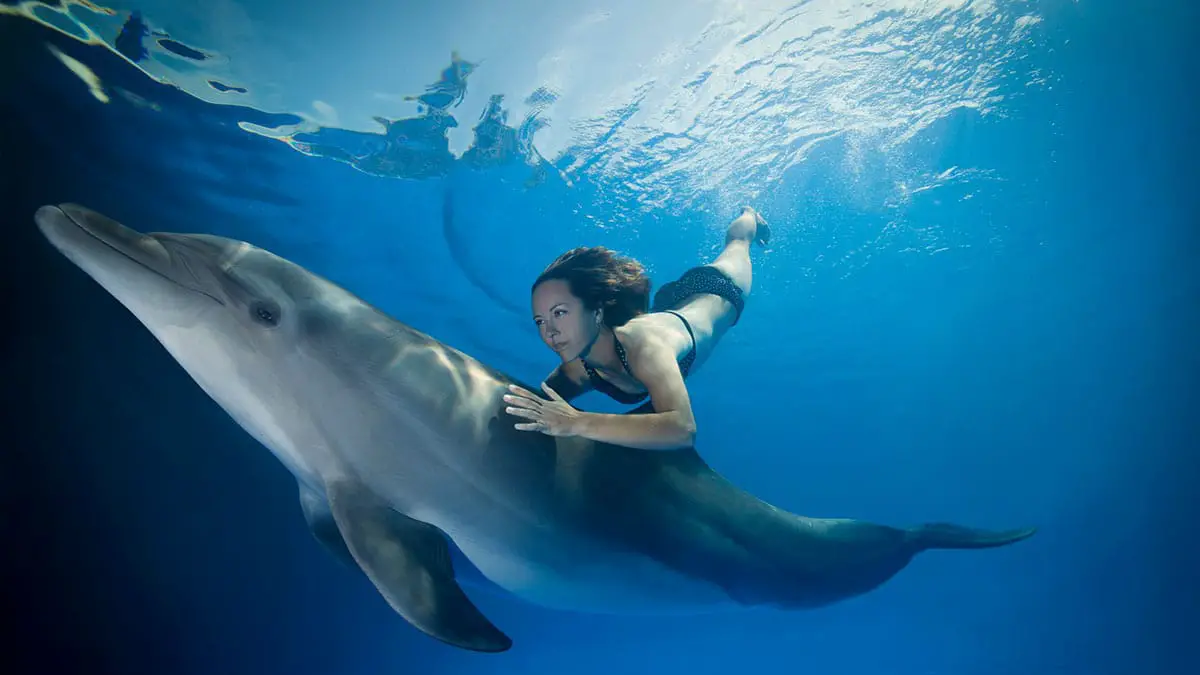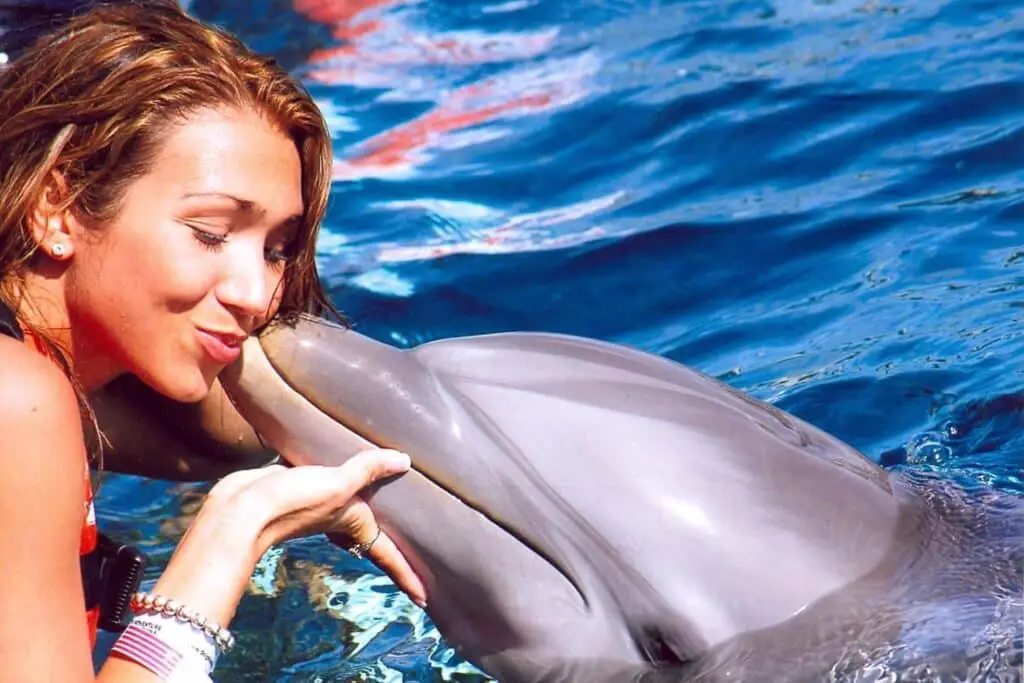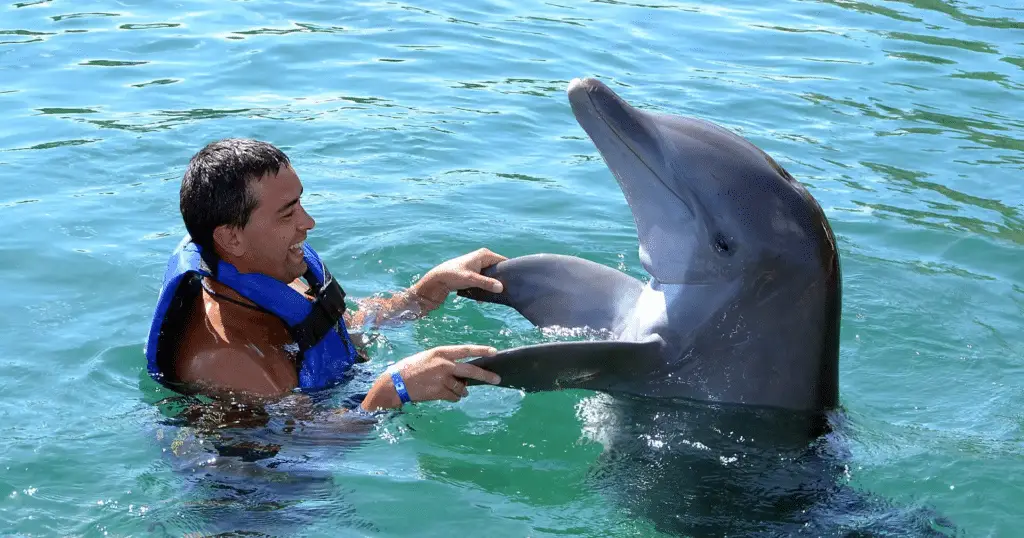Do Dolphins Save Humans

Introduction
Tales of extraordinary encounters between humans and marine creatures often capture our imaginations in the vast and mysterious realm of the world’s oceans. One of the most compelling narratives revolves around the remarkable relationship between dolphins and people, where these intelligent and benevolent creatures seem to come to the rescue when humans find themselves in difficult situations at sea.
The world’s seas are huge and have no end. They are full of secrets and wonders that keep catching our attention. Dolphins helping people in trouble is one of these deep blue waters’ most exciting and heartwarming stories. These fantastic stories have given people a long-lasting interest in dolphins and a strong belief in their ability to save lives in the water. But can these intelligent and mysterious creatures help us when we’re in trouble at sea?
In this investigation, we go deep into the science, folklore, and extraordinary real-life meetings to discover the relationship between people and dolphins.

Have dolphins saved humans?
There have been many stories of dolphins coming to the aid of swimmers or sailors in trouble and even guiding them to safety. A group of dolphins saved a surfer from being attacked by a great white shark. Even though these stories are often strange and sometimes sound like folklore, some are well-researched and backed up by solid proof. Here are just a few:
Dick Van Dyke’s Dolphin Rescue:
The actor Dick Van Dyke once shared how he was caught in a strong riptide while surfing in California. According to his account, a pod of dolphins formed a protective circle around him, preventing him from being pulled further to sea. While some skeptics question the accuracy of this story, Van Dyke maintains that it was a genuine rescue by dolphins.
The Lifeguard’s Friend:
In 2004, lifeguard Rob Howes and his daughter were swimming off the coast of New Zealand when dolphins surrounded them. The dolphins started acting strangely, swimming in tight circles and hitting the water with their tails. The lifeguard noticed this, and he soon realized they were keeping a great white shark away from him and his daughter, keeping them safe.
The Case of Adam Walker:
2014 British swimmer Adam Walker attempted to swim across the Cook Strait in New Zealand when a giant shark approached him. A pod of dolphins suddenly appeared and surrounded him, forming a protective barrier between him and the shark. This allowed Walker to complete his swim safely.
While these stories are indeed remarkable, it’s important to note that such dolphin rescues are relatively rare and often occur under specific circumstances. Dolphins are brilliant and social animals, and their actions can sometimes be interpreted as protective behaviors towards humans when they sense danger. However, the exact motivations behind these actions remain a scientific study and debate subject.
Why do dolphins try to save humans?
Some scientists believe that dolphins instinctively come to the assistance of other injured dolphins and that it’s a small step for them to help humans, too. However, dolphins realize that humans aren’t dolphins. Some scientists think dolphins help humans merely because they are curious.
The idea that dolphins “save” people purposefully is exciting and has been discussed. Dolphins have been seen helping or protecting people in trouble, but we don’t fully understand why. Several theories and factors may explain why dolphins sometimes help people in ways that could save their lives:
Instinctual Behavior: Dolphins are intelligent and social animals, and their social systems and instincts are complicated. Some researchers think their protective behavior may be a natural extension of their desire to protect and care for their pod members. This could spread to other animals, including people, that they see in trouble.
Curiosity: Dolphins are known for their interest and inquisitiveness. When they encounter unusual or distressed creatures in the water, they may investigate and attempt to understand the situation, which could lead to actions that appear to be protective.
Communication: Dolphins use a wide range of vocalizations and body language to communicate with each other. They may use these communication skills to signal and coordinate protective actions when encountering a distressed swimmer or diver.
Habituation: In places where dolphins often see people, they may get used to our presence and learn to link certain behaviors or events to humans. If they see a person in trouble, they might react in a way that makes sense based on what they have learned.
Empathy or Altruism: Even though it’s hard to say that animals have feelings like empathy or altruism, some researchers think that dolphins may act in a way that seems generous because they want to help others in need.
Are dolphins safe for humans?
Even though dolphinariums might tell you otherwise, dolphins are the top predators in the water and can even kill sharks. They should be treated as such. Dolphins can be mean to people and other dolphins, or they can hurt themselves. Even though most dolphins in the US are born and raised in captivity, they are not pets.
Dolphins are generally considered safe for humans and known for their friendly and playful nature. However, it’s essential to understand that dolphins are wild animals, and their behavior can vary depending on several factors, including the species of dolphin and the specific circumstances of the encounter. Here are some essential points to consider:
Friendliness
People usually think of dolphins as friendly and fascinating animals. People have seen them swim up to boats, talk to swimmers, and act like they’re having fun. Many people have had pleasure and memorable times swimming with dolphins or connecting with them in other ways.
Social Nature
Dolphins are highly social creatures and often travel in pods. Their interactions with humans can sometimes reflect their natural desire for social interaction and play.
Respect for Wildlife
When you see dolphins in the wild, it’s important to respect them and follow the rules for responsibly watching wildlife. If you get too close to dolphins, feed them, or try to touch or ride them, you can mess up their everyday behaviors and make them feel stressed.
Safety Considerations
While dolphins are generally not a threat to humans, it’s important to remember that they are large and powerful animals. In rare cases, dolphins have displayed aggressive behavior, especially when they feel threatened or cornered. To ensure safety for both humans and dolphins, it’s advisable to maintain a safe and respectful distance in the wild.
Legal Protections
In many regions, laws and regulations are in place to protect dolphins and other marine wildlife. These laws are intended to prevent harassment and ensure the well-being of these creatures.
Has a dolphin ever attacked a human?
Dolphin attacks on humans are rare, but they do happen. In 2019, a woman named Valerie Ryan was bitten by a dolphin while swimming in Hawaii. The attack caused internal injuries, including spinal fractures, broken ribs, and a damaged lung.
Dolphin attacks on humans are sporadic and considered highly unusual for marine mammals. Dolphins are generally known for their friendly and playful interactions with humans, and they are not regarded as aggressive predators like other marine animals, such as sharks.
Instances of dolphins behaving aggressively toward humans are infrequent and typically occur under specific circumstances, such as when a dolphin feels threatened or stressed. These circumstances might include:
Provocation: Aggressive behavior may occur if a human engages in behaviors that provoke or harass a dolphin, such as trying to touch or ride it, cornering it, or feeding it.
Protecting Young: Like many other animals, mother dolphins can protect their young. If a mother dolphin thinks her babies are in danger, she may roughly defend them.
Stress or Disorientation: Dolphins may display aggressive behaviors if stressed, injured, or disoriented. Approaching a stressed or injured dolphin can be dangerous, as it may lash out in self-defense.
Mistaken Identity: In sporadic cases, a dolphin may mistake a human for prey or an unfamiliar object, leading to an aggressive interaction.
How do dolphins see humans?
Researchers have used sophisticated audio processing tools to create the first map of what a dolphin “sees” when it uses echolocation on a human being.
We don’t know everything about how dolphins see people because we can’t directly reach their senses or thoughts. But we can make educated guesses based on what we know about dolphin behavior, their feelings, and how they connect with people.
Visual Perception: Dolphins have good eyesight and can see things in the water where they live. They can see colors well and may be able to tell the difference between some human shapes and traits. But it’s important to remember that things like the clarity of the water, the amount of light, and the distance between the dolphin and the person can change how well they can see.
Echolocation: Most of the time, dolphins use echolocation, like biological radar, to find their way around and find things in their environment. They make high-pitched clicks, and the echoes help them make mental pictures of their surroundings. Echolocation is a great way to find prey and dodge obstacles, but it might not be able to tell you what people look like.
Behavioral Observations: Dolphins are known to be curious animals. They often approach and interact with humans, displaying behaviors like circling, leaping, and playing. These interactions suggest that dolphins may perceive humans as exciting or novel beings in their environment.
Communication: Dolphins are highly communicative and use vocalizations and body language to convey information and emotions within their pods. When interacting with humans, they may emit various sounds or engage in physical contact, which could be a form of communication or social interaction.
Are dolphins the friendliest animal?
The playful and friendly dolphin is also one of the most intelligent mammals. Nobody is sure about the inner lives of sea sponges, so scientists usually name dolphins as the most friendly residents of the seas. The playful aquatic mammals also rank among the most intelligent species.
Dolphins are often considered friendliest animals in the animal kingdom, particularly in their interactions with humans. Their reputation for friendliness is primarily based on the following characteristics:
Playful Nature: Dolphins are known for their active behaviors, such as leaping out of the water, riding waves, and engaging in games with other dolphins and, occasionally, with humans. These active actions can create a sense of friendliness and curiosity.
Social Bonds: Dolphins are highly social creatures and form strong bonds within their pods (groups). Their cooperative and communal behaviors, including hunting and traveling together, can indicate friendliness within their communities.
Interactions with Humans: Dolphins swim up to boats, swimmers, and divers out of curiosity and sometimes to connect with them gently. Swimming with dolphins has been a fun and unique experience for many people, which adds to the idea that dolphins are friendly animals.
Intelligence: Dolphins are among the most intelligent animals on Earth, and their cognitive abilities, problem-solving skills, and learning capacity are often associated with advanced and friendly behaviors.
However, it’s important to note that not all dolphin species and individuals behave the same way, and there can be variability in their interactions with humans. While some dolphins are known for their friendliness, others may be more cautious or indifferent.

Conclusion
In the vast and enigmatic world of the ocean, where nature’s wonders often defy explanation, the remarkable relationship between humans and dolphins continues to captivate our imagination. Whether dolphins can save humans from dangerous situations at sea has sparked fascination and debate, blending science, folklore, and real-life encounters into a compelling narrative.
As we’ve looked at stories and scientific facts about this question, it’s become clear that dolphins are more than just creatures of the sea. They have special abilities that make them more than just fish. Due to their intelligence, strong social bonds, and natural curiosity, dolphins have sometimes helped people in trouble. Dolphins have left an indelible mark on our collective psyche as possible aquatic saviors, whether through protective behaviors, helping in dangerous situations, or being there when needed.



